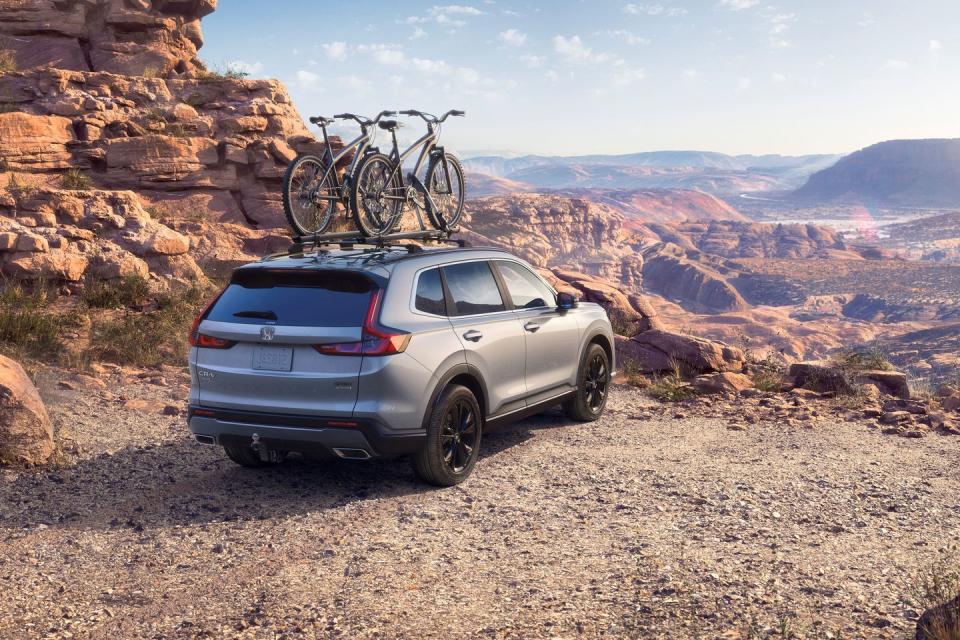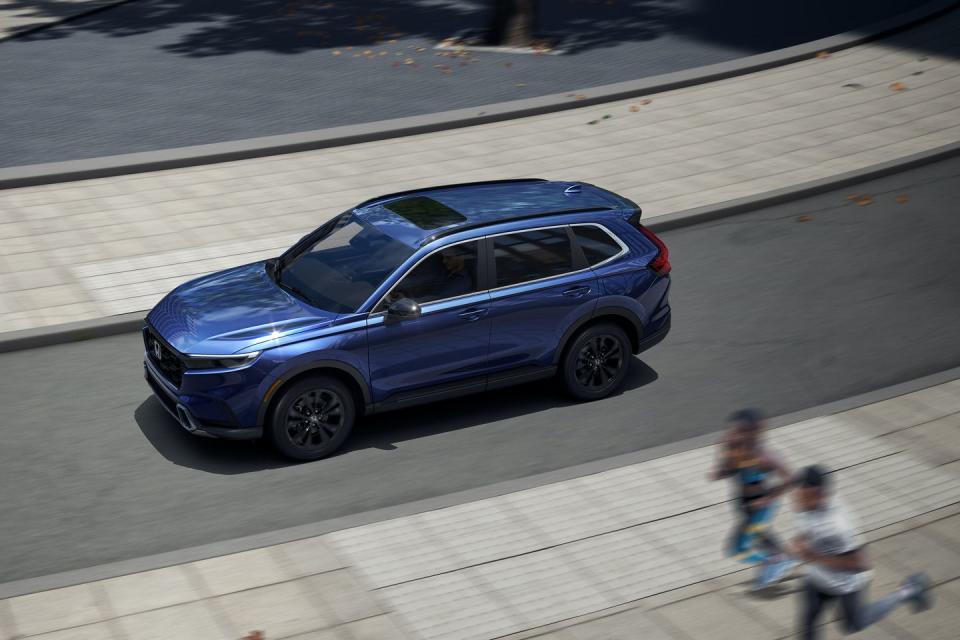2023 Honda CR-V Improves Incrementally

Honda didn't need to reinvent the CR-V for 2023, as it is already one of the bestselling compact SUVs in the U.S. and the automaker's most popular model. For its sixth generation, the CR-V grows slightly, sports a more upright and squared-off front end, and has a modernized cabin with larger touchscreens and higher-quality materials.
We traveled to Nashville, Tennessee, to take a spin in this all-new CR-V. Our sample car, a midrange EX-L, came finished in Radiant Red paint and rode on 18-inch wheels that are fitted to much of the range. While not as outwardly bold as the 2023 Kia Sportage or the Hyundai Tucson, the new CR-V cuts a more stylish path through traffic than the outgoing version.
Not that there was much traffic to navigate on the meandering country lanes that constituted our test drive around the Nashville Superspeedway, a 1.3-mile tri-oval located 30 miles east of downtown. The racy staging point was an ironic twist, considering the CR-V's mission is to transport up to five people and plenty of cargo comfortably and economically with stress-free driving dynamics.

By the numbers, the 2023 CR-V is 2.7 inches longer, rides on a wheelbase stretched up to 1.6 inches, and has slightly wider front and rear tracks (0.4 to 0.5 inch front and 0.3 to 0.5 inch rear) than the previous model. This pays off with a bit more rear legroom and slightly increased cargo volume with the rear seatbacks folded, now 77 cubes, while the 39 cubic feet behind the second row is the same as before. Thanks to its nearly flat floor and ample glass area, the CR-V's cabin is a light and airy place to spend your time.
Two Familiar Engines
A turbocharged 1.5-liter four-cylinder returns, delivering the same 190 horsepower and 179 pound-feet of torque as before, although peak torque arrives a few hundred rpm sooner. This engine is again coupled to a continuously variable automatic transmission, and the CR-V is available with front- or all-wheel drive. Our EX-L was equipped with all-wheel drive, and the updated system can now send more torque to the rear wheels—up to 50 percent versus a max of 40 percent previously. The CR-V also adds hill-descent control.

While the turbocharged 1.5-liter powers the EX and EX-L models, a 2.0-liter four-cylinder coupled with two electric motors is found in the top two trims, Sport Hybrid and Sport Touring Hybrid. It makes 204 horsepower (down from 212 horses previously) and 247 pound-feet. The hybrid variant, however, won't be available until later this year. EPA estimates are not yet available but shouldn't stray far from last year's 30 mpg combined for the front-wheel-drive 1.5-liter and 29 mpg for the AWD version. The AWD hybrid previously was good for 38 mpg overall, but the new Sport Hybrid also is available with front-wheel drive, which should result in a slight increase. (We averaged 30 mpg in our long-term test of a 2021 CR-V Hybrid.)
Performance with the standard engine is fine for a vehicle in this segment. The turbo four-cylinder fades into the background and the transmission makes the most of the available power. Acceleration is modest, though the CR-V gets up to speed without you needing to pin the gas pedal to the floor. If you do, the result is simply more engine noise.
Our drive loop consisted of well-groomed two-lane roads, though we attempted to flummox the suspension by aiming for any bumps and ruts encountered along the way. To its credit, the CR-V was unflustered and extremely quiet at a steady cruise. Honda stiffened the chassis and reinforced the front and rear suspension, the result being a very smooth ride and steering that's light and accurate. Unfortunately, the handling doesn't have the fun-loving nature found in some rivals, most notably the Mazda CX-50. To be fair, driving excitement doesn't rank high among must-haves for many shoppers in this segment.

Upgraded Interior and New Features
More important is the fact that the 2023 CR-V now comes standard with more driver-assist features, including blind-spot monitoring, rear cross-traffic alert, and adaptive cruise control. Also new are a driver-attention monitor and a rear-seat reminder. Buyers may be more likely to appreciate the infotainment system's clearer menus and quicker response times. Our EX-L tester came with the larger 9.0-inch touchscreen with wireless smartphone connectivity and wireless charging, an upgrade over the base 7.0-inch system, with wired Apple CarPlay and Android Auto, found in the EX and Sport. All models get a digital instrument cluster. Honeycomb-patterned trim that neatly hides the air vents, a sleek design flourish first introduced on the Civic sedan, dresses up the dashboard itself.
Improvements to the CR-V are incremental, true, but this practical and value-oriented SUV already ranked among the best in its crowded segment. Honda made a good thing a little bit better with the 2023 CR-V, and that's probably enough.

You Might Also Like

 Yahoo Autos
Yahoo Autos 
